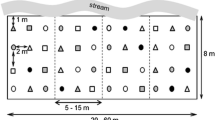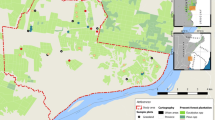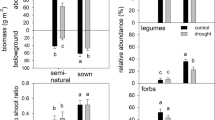Abstract
The occurrence of tree deaths in young, 3 to 6 year old Eucalyptus globulus plantations established on farmland in south-western Australia was found to be strongly related to factors indicative of poor soil water storage capacity. Seven years after planting tree survival was significantly less on soils <2 m deep compared to >2 m deep (22% vs 70%). This is due to the limited ability of some soils to store a sufficient proportion of the annual rainfall within the root-zone to meet the plant water demand in a region with a recurrent annual summer drought. There are practical difficulties in routinely surveying soils to depths in excess of 2 m over broad areas, to predict the likelihood of tree death. On the granitic basement rocks of south-west Western Australia, the occurrence of ferricrete gravels provides a useful surrogate indicator for the presence of deeper soils. In this region the distribution of soil depth and soil fertility has a geomorphic basis, being related to previous patterns of deep weathering and regolith stripping. Soils have developed on various horizons of deeply weathered profiles, formed from granites and gneisses. These materials have been stripped to a variable extent by erosion, leading to a range of soil depths. The original weathered profiles, which correspond to the soils with ferricrete gravels, comprise the deepest soil/regolith materials (~30-50 m deep); whereas along drainage lines the regolith has been completely stripped, the soils are shallow and plantations are most susceptible to drought. Knowledge of the relationship between soil depth and plantation performance allows regional indications of drought risk to be developed from regional soil mapping and the production of more efficient sampling designs for site assessment.




Similar content being viewed by others
References
Bettenay E, Mulcahy MJ (1972) Soil and landscape studies in Western Australia. (2) Valley form and surface features of the south–west drainage division. J Geol Soc Aust 18:359–369
Chiew FHS, McMahon TA (1992) An Australian comparison of Penman’s potential evapotranspiration estimates and class A evaporation pan data. Aust J Soil Res 30:101–112. doi:10.1071/SR9920101
Dell B, Bartle JR, Tacey WH (1983) Root occupation and root channels of jarrah forest subsoils. Aust J Bot 31:615–627. doi:10.1071/BT9830615
Finkl CW, Churchward HM (1973) The etched landsurfaces of southwestern Australia. J Geol Soc Aust 20:295–307
Harper RJ, Smettem KRJ, Tomlinson RJ (2005) Using soil and climatic data to estimate the performance of trees, carbon sequestration and recharge potential at the catchment scale. Aust J Exp Agric 45:1389–1401. doi:10.1071/EA04186
Harper RJ, Beck AC, Ritson P, Hill MJ, Mitchell CD, Barrett DJ, Smettem KRJ, Mann SS (2007) The potential of greenhouse sinks to underwrite improved land management. Ecol Eng 29:329–341. doi:10.1016/j.ecoleng.2006.09.025
Harper RJ, Smettem KRJ, Reid RF, Callister A, McGrath JF, Brennan PB (2009) Pulpwood Crops. In: Reid RF, Nuberg I (eds) Agroforestry for natural resource management. CSIRO, Melbourne
Havel JJ (1975) Site vegetation mapping in the northern jarrah forest (Darling Range). 2. Location and mapping of site—vegetation types. In For. Dep. West. Aust. Bull. Forests Department of Western Australia, p 105
Jeffrey SJ, Carter JO, Moodie KB, Beswick AR (2001) Using spatial interpolation to construct a comprehensive archive of Australian climate data. Environ Model Softw 16:309–330. doi:10.1016/S1364-8152(01)00008-1
Lange RT (1960) Rainfall and soil control of tree species distribution around Narrogin, Western Australia. J R Soc West Aust 43:104–110
McArthur WM (1991) Reference Soils of South-western Australia. Australian Society of Soil Science Inc. WA Branch, Perth, p 265
McDonald RC, Isbell RF, Speight JG, Walker J, Hopkins MS (1990) Australian soil and land survey field handbook. Inkata, Melbourne
McGrath JF, Ward D, Jenkins PJ, Read B (1991) Influence of site factors on the productivity and drought susceptibility of Pinus radiata in the Blackwood Valley Region of Western Australia. In: Ryan PJ (ed) Productivity in perspective. Third Australian forest soils and nutrition conference. Forestry Commission of New South Wales, Sydney, Melbourne, pp 65–66
Mulcahy MJ (1967) Landscapes, laterites and soils in southwestern Australia. In: Jennings JN, Mabbutt JA (eds) Landform Studies from Australia and New Guinea. ANU, Canberra, pp 211–230
National Land and Water Resources Audit (2001) Dryland Salinity in Australia. A summary of the National Land and Water Resources Audit’s Australian Dryland Salinity Assessment 2000. National Land and Water Resources Audit, Canberra
Parsons M, Gavran M (2007) National plantation inventory Australia — 2007 Update. Department of Agriculture, Fisheries and Forestry, Canberra, p 8
Pracilio G, Adams ML, Smettem KRJ, Harper RJ (2006) Determination of spatial distribution patterns of clay and plant available potassium contents in surface soils at the farm scale using high resolution gamma ray spectrometry. Plant Soil 282:67–82. doi:10.1007/s11104-005-5229-1
Rayment GE, Higginson FR (1992) Australian laboratory handbook of soil and water chemical methods. Inkata, Melbourne, p 330
Rickert KG, McKeon GM (1982) Soil water balance model: WATSUP. Proc Aust Soc Anim Prod 14:198–200
Rickert KG, Stuth JW, McKeon GM (2000) Modelling pasture and animal production. In: Mannetje L, Jones RM (eds) Field and Laboratory Methods for Grassland and Animal Production Research. CABI, New York, pp 29–66
Robinson N, Harper RJ, Smettem KRJ (2006) Soil water depletion by Eucalyptus spp. integrated into dryland agricultural systems. Plant Soil 286:141–151. doi:10.1007/s11104-006-9032-4
Ryan PJ, Harper RJ, Laffan MD, Booth TH, McKenzie NJ (2002) Site assessment for farm forestry in Australia and its relationship to scale, productivity and sustainability. For Ecol Manage 171:133–152
Sochacki S, Harper R, Smettem K (2007) Estimation of woody biomass production from a short rotation bio-energy system in semi-arid Australia. Biomass Bioenergy 31:608–616. doi:10.1016/j.biombioe.2007.06.020
Stephens CG (1946) Pedogenesis following the dissection of lateritic regions in southern Australia. Council for Scientific and Industrial Research, p 21
Turton AG, Marsh NL, McKenzie RM (1961) Morphological, chemical and minor element data on lateritic and non-lateritic profiles from south-western Australia. CSIRO Australia Division of Soils
Valentine KWG (1986) Soil resource surveys for forestry. Soil, terrainand site mapping in boreal and temperate forests. Oxford University Press, Oxford, p 147
Webster R (1979) Exploratory and descriptive uses of multivariate analysis in soil survey. In: Wrigley N (ed) Statistical Applications in the Spatial Sciences. Pion, London, pp 286–306
Acknowledgments
We would like to thank Drs Eric Hopkins and Stuart Crombie for useful discussion. Bob Hingston, Shelley McArthur, Ted Reilly, Steve Ward and Lin Wong assisted in the field and laboratory.
Author information
Authors and Affiliations
Corresponding author
Additional information
Responsible Editor: Peter J. Gregory.
Rights and permissions
About this article
Cite this article
Harper, R.J., Smettem, K.R.J., Carter, J.O. et al. Drought deaths in Eucalyptus globulus (Labill.) plantations in relation to soils, geomorphology and climate. Plant Soil 324, 199–207 (2009). https://doi.org/10.1007/s11104-009-9944-x
Received:
Accepted:
Published:
Issue Date:
DOI: https://doi.org/10.1007/s11104-009-9944-x




